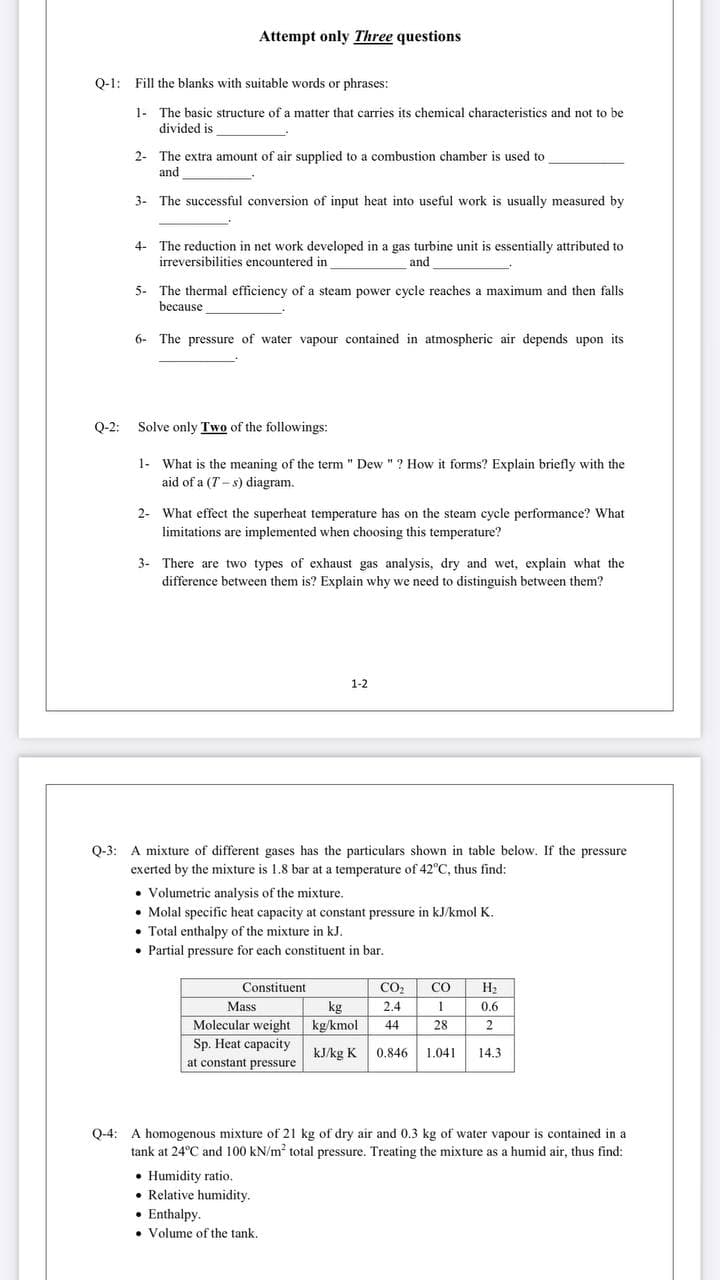Q-1: Fill the blanks with suitable words or phrases: 1- The basic structure of a matter that carries its chemical characteristies and not to be divided is 2- The extra amount of air supplied to a combustion chamber is used to and 3- The successful conversion of input heat into useful work is usually measured by
Q-1: Fill the blanks with suitable words or phrases: 1- The basic structure of a matter that carries its chemical characteristies and not to be divided is 2- The extra amount of air supplied to a combustion chamber is used to and 3- The successful conversion of input heat into useful work is usually measured by
Principles of Heat Transfer (Activate Learning with these NEW titles from Engineering!)
8th Edition
ISBN:9781305387102
Author:Kreith, Frank; Manglik, Raj M.
Publisher:Kreith, Frank; Manglik, Raj M.
Chapter1: Basic Modes Of Heat Transfer
Section: Chapter Questions
Problem 1.3DP
Related questions
Question

Transcribed Image Text:Attempt only Three questions
Q-1: Fill the blanks with suitable words or phrases:
1-
The basic structure of a matter that carries its chemical characteristics and not to be
divided is
2- The extra amount of air supplied to a combustion chamber is used to
and
3- The successful conversion of input heat into useful work is usually measured by
4- The reduction in net work developed in a gas turbine unit is essentially attributed to
irreversibilities encountered in
and
5- The thermal efficiency of a steam power cycle reaches a maximum and then falls
because
6- The pressure of water vapour contained in atmospheric air depends upon its
Q-2:
Solve only Two of the followings:
1- What is the meaning of the term " Dew
? How it forms? Explain briefly with the
aid of a (T- s) diagram.
2- What effect the superheat temperature has on the steam cycle performance? What
limitations are implemented when choosing this temperature?
3- There are two types of exhaust gas analysis, dry and wet, explain what the
difference between them is? Explain why we need to distinguish between them?
1-2
Q-3: A mixture of different gases has the particulars shown in table below. If the pressure
exerted by the mixture is 1.8 bar at a temperature of 42°C, thus find:
• Volumetric analysis of the mixture.
• Molal specific heat capacity at constant pressure in kJ/kmol K.
• Total enthalpy of the mixture in kJ.
• Partial pressure for each constituent in bar.
Constituent
CO
CO
H2
Mass
kg
2.4
0.6
Molecular weight
kg/kmol
44
28
2
Sp. Heat capacity
kJ/kg K
0,846
1.041
14.3
at constant pressure
Q-4: A homogenous mixture of 21 kg of dry air and 0.3 kg of water vapour is contained in a
tank at 24°C and 100 kN/m total pressure. Treating the mixture as a humid air, thus find:
• Humidity ratio.
• Relative humidity.
• Enthalpy.
• Volume of the tank,
Expert Solution
This question has been solved!
Explore an expertly crafted, step-by-step solution for a thorough understanding of key concepts.
This is a popular solution!
Trending now
This is a popular solution!
Step by step
Solved in 2 steps

Knowledge Booster
Learn more about
Need a deep-dive on the concept behind this application? Look no further. Learn more about this topic, mechanical-engineering and related others by exploring similar questions and additional content below.Recommended textbooks for you

Principles of Heat Transfer (Activate Learning wi…
Mechanical Engineering
ISBN:
9781305387102
Author:
Kreith, Frank; Manglik, Raj M.
Publisher:
Cengage Learning

Welding: Principles and Applications (MindTap Cou…
Mechanical Engineering
ISBN:
9781305494695
Author:
Larry Jeffus
Publisher:
Cengage Learning

Principles of Heat Transfer (Activate Learning wi…
Mechanical Engineering
ISBN:
9781305387102
Author:
Kreith, Frank; Manglik, Raj M.
Publisher:
Cengage Learning

Welding: Principles and Applications (MindTap Cou…
Mechanical Engineering
ISBN:
9781305494695
Author:
Larry Jeffus
Publisher:
Cengage Learning